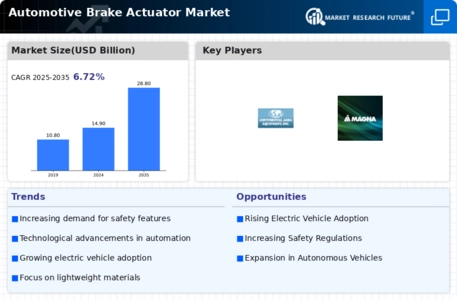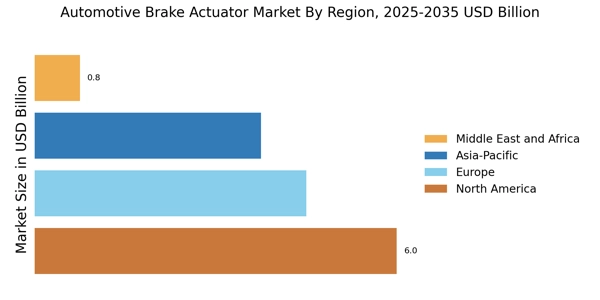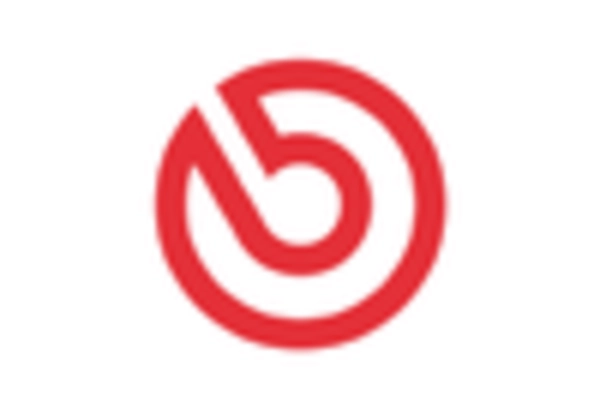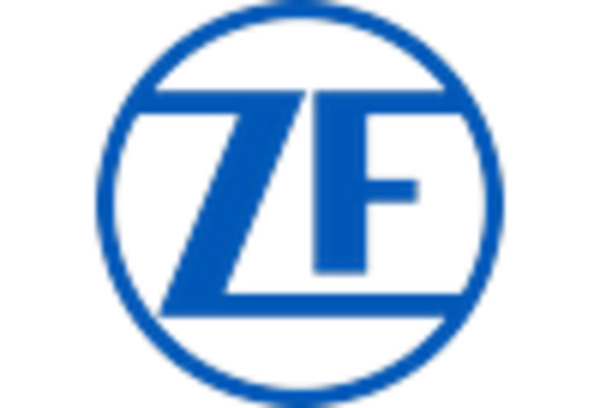Growing Demand for Electric Vehicles
The Automotive Brake Actuator Market is significantly influenced by the rising demand for electric vehicles (EVs). As manufacturers pivot towards electrification, the need for specialized brake actuators that cater to EV specifications becomes paramount. Electric vehicles often require unique braking systems that can handle regenerative braking, which recovers energy during deceleration. This shift is likely to drive innovation in brake actuator design, as companies strive to create systems that are lightweight and efficient. Market analysis suggests that the EV segment is expected to account for over 30% of the total automotive market by 2030, thereby propelling the demand for advanced brake actuators tailored for electric applications.
Regulatory Compliance and Safety Standards
The Automotive Brake Actuator Market is also shaped by stringent regulatory compliance and safety standards imposed by various authorities. Governments worldwide are increasingly mandating higher safety benchmarks for vehicles, which directly impacts the design and functionality of brake actuators. Compliance with these regulations often necessitates the incorporation of advanced technologies, such as anti-lock braking systems (ABS) and electronic stability control (ESC). As a result, manufacturers are compelled to innovate and enhance their brake actuator offerings to meet these evolving standards. Data indicates that the market for safety-compliant automotive components is projected to grow by 6% annually, underscoring the importance of regulatory adherence in driving market growth.
Rising Consumer Awareness of Vehicle Safety
The Automotive Brake Actuator Market is witnessing a notable increase in consumer awareness regarding vehicle safety features. As consumers become more informed about the importance of advanced braking systems, there is a growing preference for vehicles equipped with high-quality brake actuators. This trend is likely to influence purchasing decisions, with consumers favoring models that offer superior braking performance and reliability. Manufacturers are responding to this demand by investing in research and development to enhance the safety features of their vehicles. Market trends suggest that the emphasis on safety is expected to contribute to a 5% increase in the demand for advanced brake actuators over the next few years, reflecting a shift in consumer priorities.
Expansion of Automotive Production Facilities
The Automotive Brake Actuator Market is benefiting from the expansion of automotive production facilities in various regions. As manufacturers increase their production capabilities, the demand for brake actuators is likely to rise correspondingly. This expansion is often driven by the need to meet the growing consumer demand for vehicles, particularly in emerging markets. Additionally, the establishment of new manufacturing plants allows for localized production of brake actuators, which can reduce costs and improve supply chain efficiency. Market data indicates that the automotive production sector is expected to grow by 4% annually, which will likely bolster the demand for brake actuators as part of the overall vehicle assembly process.
Technological Advancements in Automotive Brake Actuators
The Automotive Brake Actuator Market is experiencing a surge in technological advancements, particularly with the integration of electronic and hydraulic systems. These innovations enhance the precision and responsiveness of braking systems, thereby improving vehicle safety and performance. For instance, the adoption of advanced materials and smart sensors in brake actuators is likely to lead to more efficient braking mechanisms. As vehicles become increasingly sophisticated, the demand for high-performance brake actuators is expected to rise. Market data indicates that the segment of electronic brake actuators is projected to grow at a compound annual growth rate of approximately 8% over the next five years, reflecting the industry's shift towards more advanced braking solutions.


















Leave a Comment